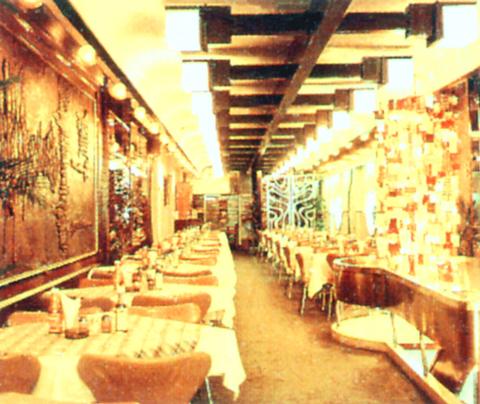If eating out were part of retro fashion, Bolero would be the "Shaft" leather trench coat of restaurants. It's "super bad." Which is to say, it's so cool.
This restaurant, located on bustling and retro-but-not-cool Minsheng West Road, is Taipei's oldest Western-style restaurant, having first opened its doors in 1934. Diners would be forgiven, however, if they thought the establishment opened in the 1970s, since the current decor dates from that time. Aside from a few touch-ups, manager Pan You-lu (

PHOTO COURTESY OF BOLERO
Downstairs, over the counter, is an odd relief of layered rectangles, while on the wall near the kitchen is a multi-hued lava lamp bubble design that is duplicated on the cover of the daily specials menu. The real gems in Bolero's decor are upstairs, which is reached by climbing the staircase with the chrome, wrap-around railing that seems to have been lifted from the Brady Bunch home. The first thing one sees on the second floor are the tan pleather chairs, which match the tinted mirrors occupying much of the wall space and the overall brown color scheme. Suspended from the ceiling is what can only be described as a massive, integrated lighting structure of lacquered dark wood with cube-shaped lamps, while on one wall is a hideous brown painting of undetermined theme. The piece de resistance, though, is the outrageous chandelier made of dangling colored squares of shiny metal that overhangs the staircase. The only period detail missing from the dining room is shag carpeting.
Though Pan finds it rather perplexing, he says the dining area is now frequently used by fashion magazines for photo shoots.
Its inimitable atmosphere aside, Bolero aims first to be a restaurant, and it succeeds quite admirably in this category. The dishes are all Western style and range from expensive ones, such as the rich and hearty black pepper steak (NT$750), to the reasonable and delicious Spanish omelette (NT$180). Pan recommends the French duck (NT$250) or the fresh lobster (NT$560). Certainly one of the restaurant's strong points are its curry dishes, which are cheap at about NT$200 and give most other curries in Taipei a good run for their money. The coffee is excellent as well.
Japanese colonial officials no longer while away evenings at Bolero, nor do convoys of raucous American GIs unload on the restaurant, but their presence is still felt. It's a wonder, then, that Pan doesn't begin charging admission.

One of the biggest sore spots in Taiwan’s historical friendship with the US came in 1979 when US president Jimmy Carter broke off formal diplomatic relations with Taiwan’s Republic of China (ROC) government so that the US could establish relations with the People’s Republic of China (PRC). Taiwan’s derecognition came purely at China’s insistence, and the US took the deal. Retired American diplomat John Tkacik, who for almost decade surrounding that schism, from 1974 to 1982, worked in embassies in Taipei and Beijing and at the Taiwan Desk in Washington DC, recently argued in the Taipei Times that “President Carter’s derecognition

This year will go down in the history books. Taiwan faces enormous turmoil and uncertainty in the coming months. Which political parties are in a good position to handle big changes? All of the main parties are beset with challenges. Taking stock, this column examined the Taiwan People’s Party (TPP) (“Huang Kuo-chang’s choking the life out of the TPP,” May 28, page 12), the Democratic Progressive Party (DPP) (“Challenges amid choppy waters for the DPP,” June 14, page 12) and the Chinese Nationalist Party (KMT) (“KMT struggles to seize opportunities as ‘interesting times’ loom,” June 20, page 11). Times like these can

Dr. Y. Tony Yang, Associate Dean of Health Policy and Population Science at George Washington University, argued last week in a piece for the Taipei Times about former president Ma Ying-jeou (馬英九) leading a student delegation to the People’s Republic of China (PRC) that, “The real question is not whether Ma’s visit helps or hurts Taiwan — it is why Taiwan lacks a sophisticated, multi-track approach to one of the most complex geopolitical relationships in the world” (“Ma’s Visit, DPP’s Blind Spot,” June 18, page 8). Yang contends that the Democratic Progressive Party (DPP) has a blind spot: “By treating any

You can tell a lot about a generation from the contents of their cool box: nowadays the barbecue ice bucket is likely to be filled with hard seltzers, non-alcoholic beers and fluorescent BuzzBallz — a particular favorite among Gen Z. Two decades ago, it was WKD, Bacardi Breezers and the odd Smirnoff Ice bobbing in a puddle of melted ice. And while nostalgia may have brought back some alcopops, the new wave of ready-to-drink (RTD) options look and taste noticeably different. It is not just the drinks that have changed, but drinking habits too, driven in part by more health-conscious consumers and